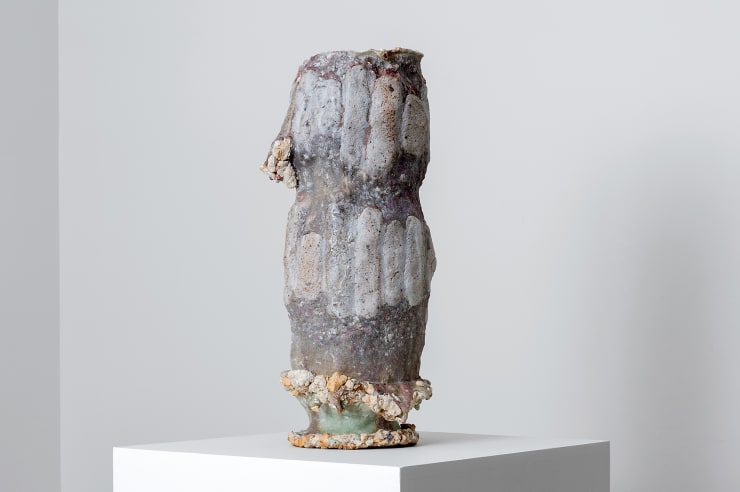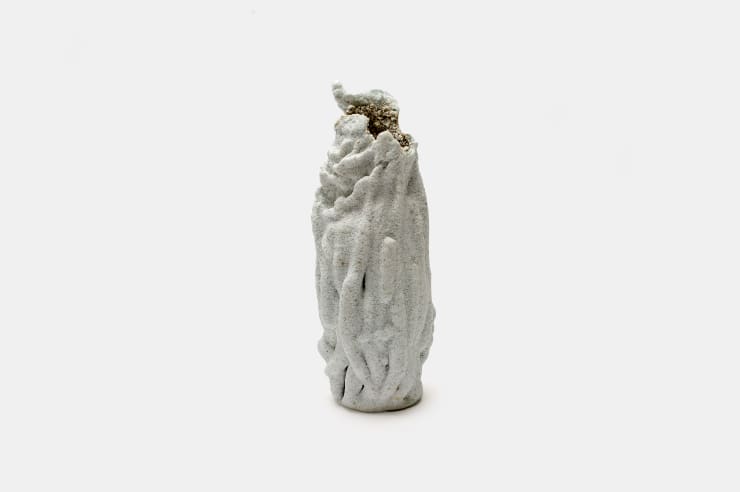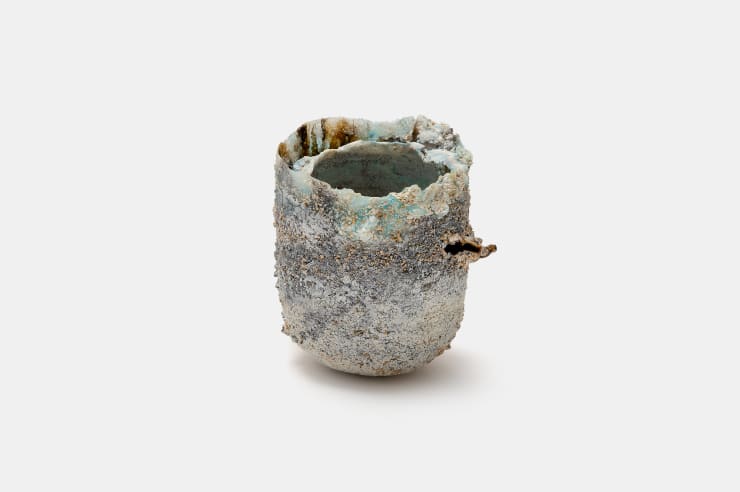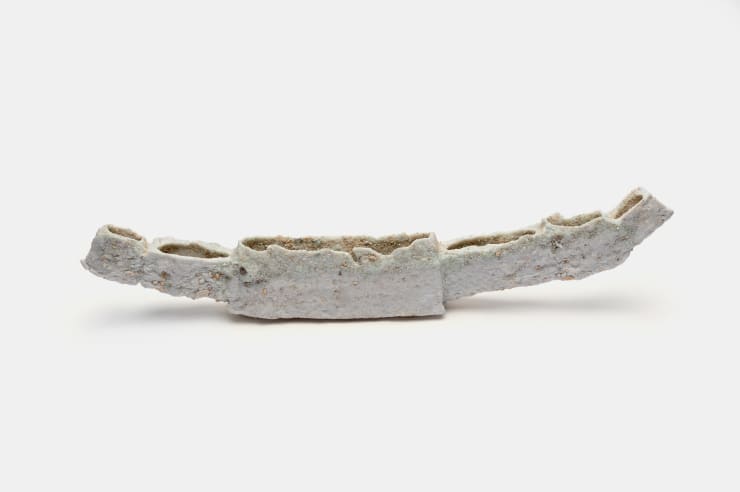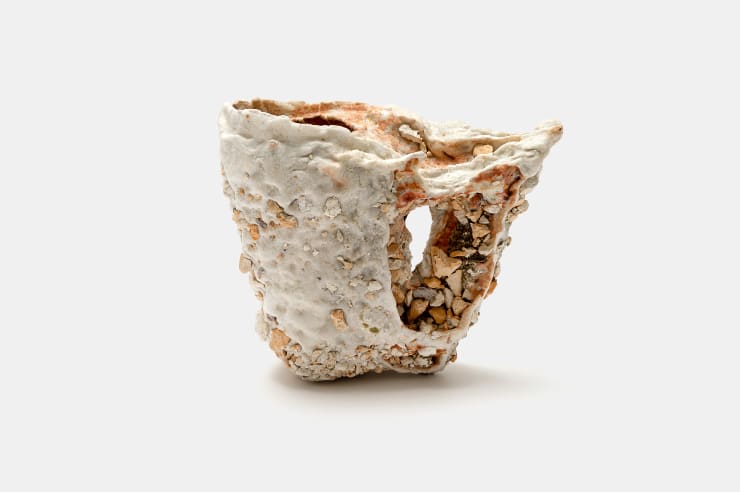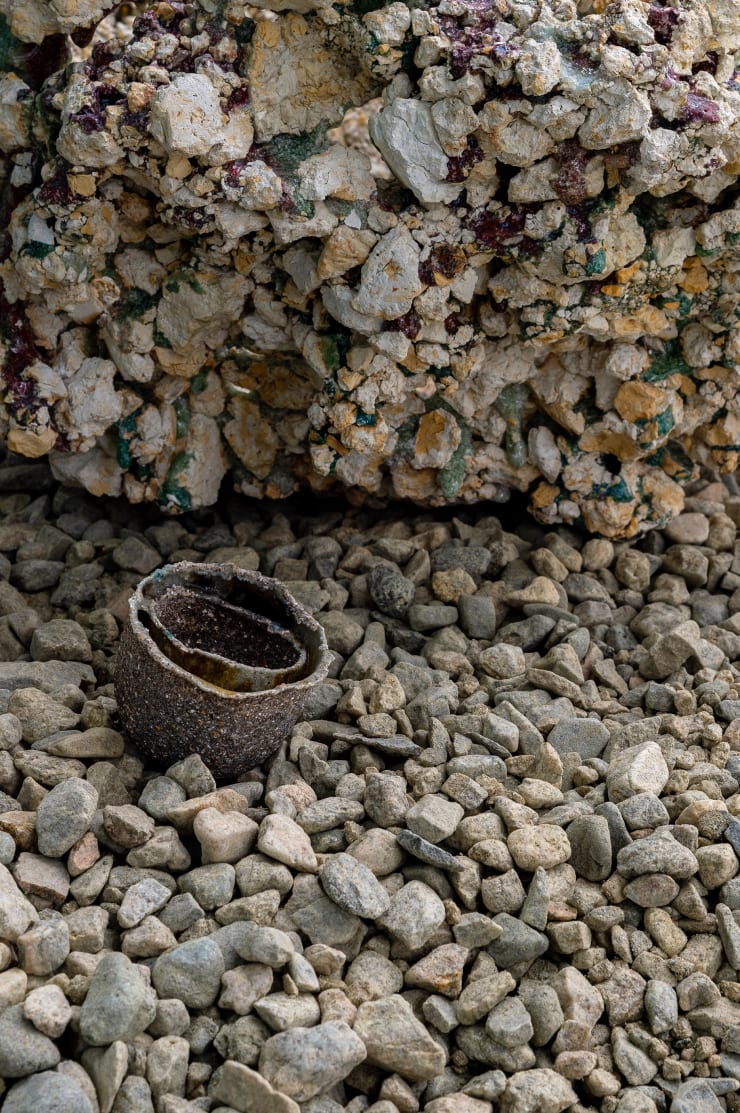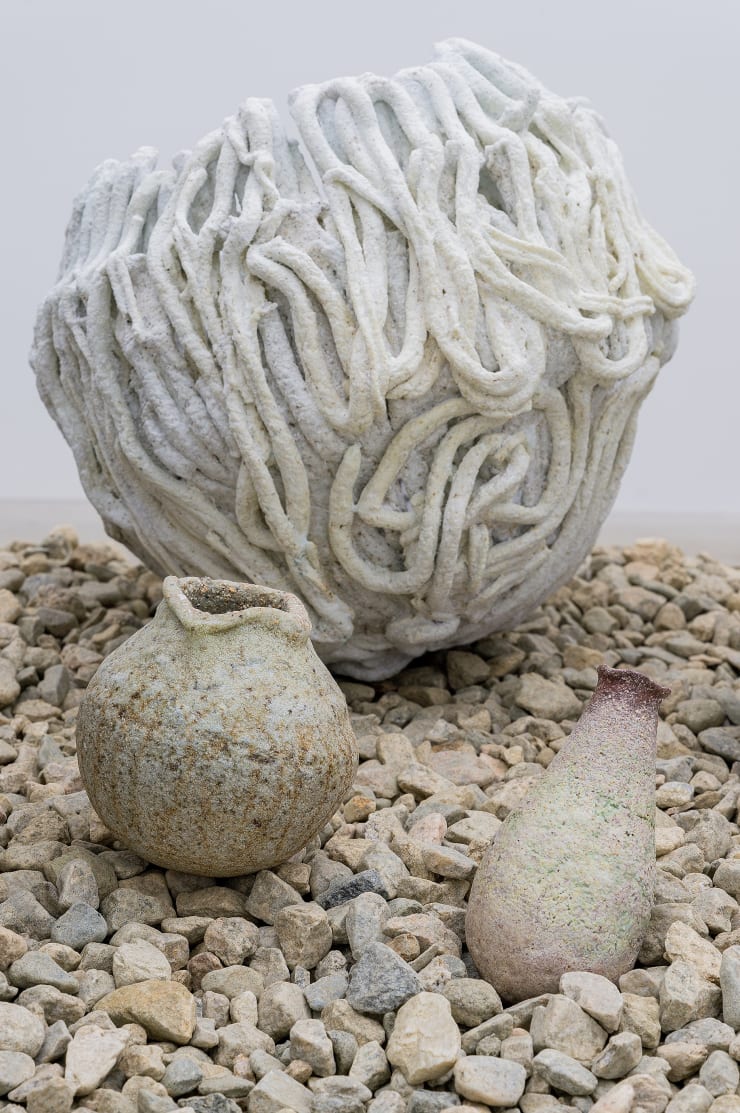Masaomi Yasunaga
Press:
Art Viewer, July 9, 2019
Los Angeles Times, July 5, 2019
Masaomi Yasunaga
(Born 1982, Osaka Japan. Living and working in Iga, Mie Prefecture, Japan)
In a gesture which has little precedence, Masaomi Yasunaga removed clay from his ceramic forms, and builds his sculptures using glaze as the primary structural element. At Nonaka-Hill, the artist’s first solo exhibition outside of Asia, Yasunaga presents numerous recent sculptures expressing a variety of vessel forms, placed on a bed of common gravel.
Yasunaga studied ceramics under Satoru Hoshino, a second-generation proponent of the avant-garde ceramic group, Sodeisha (in kanji, 走泥社 literally means, crawling through the mud). Founded in Kyoto in 1948, in the aftermath of WWII, Sodeisha broke away from long-established conventions of Japanese ceramics, resolving to create non-functional sculptural works. Continuing with this ethos, Yasunaga’s sculptures of vessels may or may not be functional, and explore an instable boundary between functional and fine arts.
By sculpting in glaze, Yasunaga’s works reimagine the use of ceramics’ conventional materials. Glaze, most commonly used to apply color, luster and finish onto the surface of clay-built ceramics, responds to different variables and often produces unexpected outcomes. Unlike clay objects which maintain their original form when fired in the kiln, Yasunaga’s glaze objects melt, so they must be buried in trays of sand, soil or rocks to retain their form. Once inside the kiln, the viscous molten glaze adheres to the surrounding earthen material. After firing and cooling, Yasunaga unburies his objects in a studio process which parallels the surprises of archeological excavation, and painstakingly removes the excess sand and rocks from the interstices of the objects. The resulting artworks range from smooth to heavily encrusted.
Yasunaga’s presentation, which verges on camouflage, resembles the beds of stone from which the works emerge after the kiln. It also embraces the narratives which his objects conjure for most viewers; that the sculptures resemble artifacts excavated from the bottom of the ocean floor or buried underground amongst ancient ruins. As such, these objects, imagined to have been lost for vast periods of time and now found, retain the global vessel styles and handiwork of imagined ceramics makers (other than Yasunaga) from eons before. Some objects seem whole, while others seem broken, arousing phenomenological thinking reflected in the artwork’s titles, all which infer something that was, or is no longer; Sai (砕) means to break or collapse, Tokeru Utsuwa (溶ける器) translates to melting vessel, Dakkaku (脱穀) is defined as threshing, and Hako No Kokkaku (箱の骨格) signifies a skeleton.
Feeling that with new life or death, comes a moment when many things may change, Yasunaga responded to the passing of his grandmother ten years ago by incorporating her cremated bone remains into the glaze of his hand-crafted funerary urns. This gesture compelled him to appreciate the emotional and expressive potentials in ceramics. Three years ago, with the joy of the birth of his eldest son, Yasunaga began to hybridize his empty container forms with depictions of animals from around where he was born. Rendered in Yasunaga’s earthen materials, these Empty creatures conjure associations to numerous histories and places, and collectively form an unlikely geologic menagerie.
Yasunaga’s exploratory approach to ceramic making delves deeper than its experimentative application of materials, his sculptures give perspective to the human relationship to time.
 Masaomi Yasunaga, Tokeru Utsuwa 熔ける器, 2019
Masaomi Yasunaga, Tokeru Utsuwa 熔ける器, 2019 Masaomi Yasunaga, Tokeru Utsuwa 熔ける器, 2019
Masaomi Yasunaga, Tokeru Utsuwa 熔ける器, 2019 Masaomi Yasunaga, Dakkaku 脱殻, 2018
Masaomi Yasunaga, Dakkaku 脱殻, 2018 Masaomi Yasunaga, Tokeru Utsuwa 熔ける器, 2019
Masaomi Yasunaga, Tokeru Utsuwa 熔ける器, 2019 Masaomi Yasunaga, Tokeru Utsuwa 熔ける器, 2019
Masaomi Yasunaga, Tokeru Utsuwa 熔ける器, 2019 Masaomi Yasunaga, Tokeru Utsuwa 熔ける器, 2019
Masaomi Yasunaga, Tokeru Utsuwa 熔ける器, 2019 Masaomi Yasunaga, Tokeru Utsuwa 熔ける器, 2019
Masaomi Yasunaga, Tokeru Utsuwa 熔ける器, 2019 Masaomi Yasunaga, Tokeru Utsuwa 熔ける器, 2018
Masaomi Yasunaga, Tokeru Utsuwa 熔ける器, 2018 Masaomi Yasunaga, Tokeru Utsuwa 熔ける器, 2019
Masaomi Yasunaga, Tokeru Utsuwa 熔ける器, 2019 Masaomi Yasunaga, Tokeau Tsubo 溶け合う壺, 2019
Masaomi Yasunaga, Tokeau Tsubo 溶け合う壺, 2019 Masaomi Yasunaga, Kaku 殻, 2019
Masaomi Yasunaga, Kaku 殻, 2019 Masaomi Yasunaga, Tokeru Utsuwa 熔ける器, 2018
Masaomi Yasunaga, Tokeru Utsuwa 熔ける器, 2018 Masaomi Yasunaga, Untitled, 2019
Masaomi Yasunaga, Untitled, 2019 Masaomi Yasunaga, Untitled, 2019
Masaomi Yasunaga, Untitled, 2019 Masaomi Yasunaga, Untitled, 2019
Masaomi Yasunaga, Untitled, 2019 Masaomi Yasunaga, Tokeau Tsubo 溶け合う壺, 2019
Masaomi Yasunaga, Tokeau Tsubo 溶け合う壺, 2019 Masaomi Yasunaga, Ishi no Utsuwa 石の器, 2018
Masaomi Yasunaga, Ishi no Utsuwa 石の器, 2018 Masaomi Yasunaga, Ishi no Utsuwa 石の器, 2018
Masaomi Yasunaga, Ishi no Utsuwa 石の器, 2018 Masaomi Yasunaga, Empty creature (空虚な生き物) , 2018
Masaomi Yasunaga, Empty creature (空虚な生き物) , 2018 Masaomi Yasunaga, Ishi no Utsuwa 石の器, 2018
Masaomi Yasunaga, Ishi no Utsuwa 石の器, 2018 Masaomi Yasunaga砕 / crumbling, 2019Glass, plaster4-3/4 x 4-3/16 x 3-3/4 inches
Masaomi Yasunaga砕 / crumbling, 2019Glass, plaster4-3/4 x 4-3/16 x 3-3/4 inches
12 x 10.5 x 9.5 cm Masaomi Yasunaga, Sai 砕, 2019
Masaomi Yasunaga, Sai 砕, 2019 Masaomi Yasunaga, Sai 砕, 2019
Masaomi Yasunaga, Sai 砕, 2019 Masaomi Yasunaga, Sai 砕, 2019
Masaomi Yasunaga, Sai 砕, 2019 Masaomi Yasunaga, Sai 砕, 2018
Masaomi Yasunaga, Sai 砕, 2018 Masaomi Yasunaga, Hako no Kokkaku 箱の骨格, 2018
Masaomi Yasunaga, Hako no Kokkaku 箱の骨格, 2018 Masaomi Yasunaga, Empty creature (空虚な生き物), 2019
Masaomi Yasunaga, Empty creature (空虚な生き物), 2019 Masaomi Yasunaga, Sai 砕, 2019
Masaomi Yasunaga, Sai 砕, 2019 Masaomi Yasunaga, Sai 砕, 2017
Masaomi Yasunaga, Sai 砕, 2017 Masaomi Yasunaga, Untitled, 2019
Masaomi Yasunaga, Untitled, 2019 Masaomi Yasunaga, Tokeru Utsuwa 熔ける器, 2019
Masaomi Yasunaga, Tokeru Utsuwa 熔ける器, 2019 Masaomi Yasunaga, Utsuwa no Kokkaku 器の骨格, 2019
Masaomi Yasunaga, Utsuwa no Kokkaku 器の骨格, 2019
Related artist
Artist Exhibited:
Ulala Imai
Kazuo Kadonaga
Kentaro Kawabata
Zenzaburo Kojima
Kisho Kurokawa
Tadaaki Kuwayama
Toshio Matsumoto
Keita Matsunaga
Yutaka Matsuzawa
Kimiyo Mishima
Kunié Sugiura
Takuro Tamayama
Tiger Tateishi
Sofu Teshigahara
Shomei Tomatsu
Wataru Tominaga
Hosai Matsubayashi XVI
Kansuke Yamamoto
Masaomi Yasunaga
Exhibitions:
-2025-
Sea of Mud, Wall of Flame: Satoru Hoshino and Masaomi Ysunaga
KEY HIRAGA: The Elegant Life of Mr. H
-2024-
KYOKO IDETSU: What can an ideology do for me?
KENTARO KAWABATA / BRUCE NAUMAN
SAORI (MADOKORO) AKUTAGAWA: CENTENARIA
Keita Matsunaga : Accumulation Flow
-2023-
NONAKA-HILL ♥ TATAMI ANTIQUES: A holiday sale of unique objects from Japan
TAKASHI HOMMA : REVOLUTION No.9 / Camera Obscura Studies
TATSUMI HIJIKATA THE LAST BUTOH: Photographs by Yasuo Kuroda
Kiyomizu Rokubey VIII: CERAMIC SIGHT
Masaomi Yasunaga: 石拾いからの発見 / discoveries from picking up stones
SHUZO AZUCHI GULLIVER ‘Synogenesis’
Koichi Enomoto: Against the day
Tatsuo Ikeda / Michael E. Smith
Hiroshi Sugito: the garden with Zenzaburo Kojima
Zenzaburo Kojima: This very green
Tomohisa Obana: To see the rainbow at night, I must make it myself
Daisuke Fukunaga: Beautiful Work
- 2021 -
Natsuyasumi: In the Beginning Was Love
Takashi Homma: mushrooms from the forest
– 2020 –
Hosai Matsubayashi XVI & Trevor Shimizu
Sterling Ruby and Masaomi Yasunaga
– 2019 –
A show about an architectural monograph
Yutaka Matsuzawa
Yutaka Matsuzawa through the lens of Mitsutoshi Hanaga
Takuro Tamayama & Tiger Tateishi
Kunié Sugiura
Masaomi Yasunaga
Miho Dohi
Wataru Tominaga
Naotaka Hiro
Parergon: Japanese Art of the 1980s and 1990s
Tadaaki Kuwayama
– 2018 –
Toshio Matsumoto
Kentaro Kawabata
Kansuke Yamamoto
Kazuo Kadonaga: Wood / Paper / Bamboo / Glass
Press:
-2025-
OCULA, Kaoru Ueda
Galerie, Kaoru Ueda
Ceramic Now, Satoru Hoshino and Masaomi Yasunaga
ARTFORUM, Sawako Goda
Artillery Magazine, Sawako Goda
-2024-
Artsy, Nonaka-Hill
Richesse, Nonaka-Hill Kyoto
Bijutsutecho, Nonaka-Hill Kyoto
The Art Newspaper, Nonaka-Hill Kyoto
Meer, Kyoko Idetsu
Bijyutsutecho, Masaomi Yasunaga
Switch, Masaomi Yasunaga
ARTnews JAPAN, Masaomi Yasunaga
Richesse, Masaomi Yasunaga
Art Basel, Daisuke Fukunaga, Imai Ulala
Art Basel, Kazuo Kadonaga, Sofu Teshigahara
-2023-
ADF webmagazine, Yasuo Kuroda, Tatsumi Hijikata
e-flux, Sanya Kantarofsky, Yasuo Kuroda
Los Angeles Times, Kenzi Shiokava
Artillery, Masaomi Yasunaga
Contemporary Art Daily Shuzo Azuchi Gulliver
- 2022 -
Contemporary Art Daily, Tomohisa Obana
ARTE FUSE, Daisuke Fukunaga
Contemporary Art Daily, Daisuke Fukunaga
Contemporary Art Review Los Angeles (Carla), Daisuke Fukunaga
What's on Los Angeles, Daisuke Fukunaga
Hyperallergic, Daisuke Fukunaga
Artillery, Kentaro Kawabata
Larchmont Buzz, entaro Kawabata
- 2021 -
Art Viewer, Natsuyasumi: In the Beginning Was Love
Hyperallergic, Natsuyasumi: In the Beginning Was Love
Art Viewer, Takashi Homma
Hyperallergic, Busy Work at Home
Art Viewer, Busy Work at Home
Hyperallergic, Ulala Imai
Contemporary Art Review Los Angeles (Carla), Ulala Imai
Contemporary Art Daily, Ulala Imai
artillery, Ulala Imai
Special Ops, Ulala Imai
Art Viewer, Ulala Imai
artillery, Matsubayashi & Trevor Shimizu
– 2020 –
Ceramic Now, Sterling Ryby and Masaomi Yasunaga
Hypebeast, Sterling Ryby and Masaomi Yasunaga
Art Viewer, Sterling Ruby and Masaomi Yasunaga
Air Mail, Sterling Ruby and Masaomi Yasunaga
Los Angeles Times, Kaz Oshiro
ArtnowLA, Kaz Oshiro
What's on Los Angeles, Kaz Oshiro
KCRW, Kaz Oshiro
Tique, Kaz Oshiro
Contemporary Art Daily, Kaz Oshiro
Art Viewer, Kaz Oshiro
Contemporary Art Daily, Sofu Teshigahara
Art Viewer, Sofu Teshigahara
KCRW, Sofu Tsshigahara
Hyperallergic, Nonaka-Hill
Los Angeles Times, Keita Matsunaga
– 2019 –
Los Angeles Times, Tatsumi Hijikata
Art Viewer, Tatsumi Hijikata, Eikoh Hosoe
Contemporary Art Review Los Angeles, Tatsumi Hijikata, Eikoh Hosoe
ArtAsiaPacific, Yutaka Matsuzawa
Los Angeles Times, Tatsumi Hijikata
AUTRE, Tatsumi Hijikata, Eikoh Hosoe
Los Angeles Times, Nonaka-Hill
ARTFORUM, Takuro Tamayama, Tiger Tateishi
Art Viewer, Takuro Tamayama, Tiger Tateishi
KCRW, Nonaka-Hill
LA WEEKLY, Nonaka-Hill
AUTRE, Takuro Tamayama, Tiger Tateishi
ArtsuZe, Takuro Tamayama, Tiger Tateishi
ARTFORUM, Review: Tadaaki Kuwayama, Rakuko Naito
Art Viewer, Masaomi Yasunaga, Kunié Sugiura
Los Angeles Times, Masaomi Yasunaga
KQED, Tadaaki Kuwayama, Rakuko Naito
Contemporary Art Daily, Naotaka Hiro, Wataru Tominaga, Miho Dohi
Los Angeles Times, Miho Dohi
Los Angeles Review of Books, Miho Dohi
Bijutsu Techo, Naotaka Hiro, Wataru Tominaga, Miho Dohi
Art Viewer, Miho Dohi
Art & Object, Parergon
COOL HUNTING, Felix Art Fair
Art Viewer, Tadaaki Kuwayama
artnet news, Nonaka-Hill
Contemporary Art Review Los Angeles (Carla), Tadaaki Kuwayama
– 2018 –
Art Viewer, Kentaro Kawabata
Contemporary Art Daily, Kazuo kadonaga
Los Angeles Times, Kazuo Kadonaga
ARTFORUM, Kazuo Kadonaga
Contemporary Art Daily, Shomei Tomatsu
KCRW, Kimiyo Mishima, Shomei Tomatsu
This website uses cookies
This site uses cookies to help make it more useful to you. Find out more about cookies.




